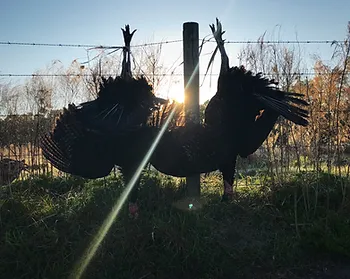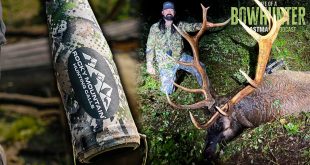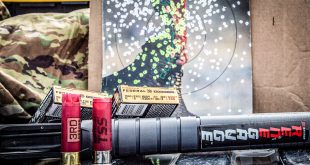The Devil’s in the Details
By Kyle Bennett and Todd Helms
With turkey seasons winding down or over all around the country Kyle Bennett and I had time to compare notes from our seasons and got to talking about tough gobblers, the lessons they taught us and how those lumps taken have made us and will make us better turkey hunters.
-Todd Helms
Here in the Deep South, wild turkeys build character.
In all my travels, of the many birds I have hunted and the beautiful landscapes I have taken in, I have yet to find a bird that treats me with the nonchalant disapproval and absolute disrespect that a Deep South Mississippi Eastern wild turkey exhibits.
What makes southern birds so difficult to hunt compared to birds in other parts of the country is a mystery. These birds have brought me to frustration, depression, and damn near insanity on occasion but growing up hunting tough turkeys has been a blessing in disguise and has increased my success on more agreeable birds across different parts of the country. This is what I’ve learned.
Keep Movement to An Absolute Minimum
If you can see a gobbler, he can certainly see you. Wild turkeys have highly adapted vision, able to see 360 degrees around them with just a slight turn of the head. I have spooked more turkeys than I care to admit by making small movements that I thought I could get away with, anything from setting down a pot call in my lap to blinking my eye to ward off a buzzing mosquito. When a gobbler is moving in to your calling setup, he is actively looking for a hen. He is ultra-perceptive to movement as he enthusiastically seeks out the imaginary hen, meaning he is very likely to catch any slight movement you make and key in on it. If a turkey decides to scrutinize you, it will rarely end in your favor.
Over the years, I’ve learned to make calculated movements at very specific times, always when the gobbler’s head is hidden out of sight. I do not call on a pot call or box call when a turkey is in sight; instead, I rely on a mouth call. If a gobbler catches me unprepared and moves into my setup while my gun is in my lap, in the past I’ve tried “quick-drawing” on turkeys, and although it may work on other birds in other parts of the world, it has never worked for me. If I need to get my gun up, I wait until the turkey’s head either passes behind a tree, or if he is in full strut, I wait until his head is behind his fan.
Break Up the Human Outline
I’ve heard the stories of guys killing turkeys in faded blue jeans and a flannel shirt. Where I hunt, a bird can and will pick you out at 200 yards through thick timber if you are wearing anything flashier than dull, natural earth tones; gloves & a facemask are necessary as well. Old-timers were piling up dead turkeys in the days before modern camouflage was available, that’s true; however, they knew that woodsmanship (a.k.a. being still and quiet and hiding the human form) was what ultimately killed turkeys. Even with today’s high-tech camouflage patterns, I’ve still been picked out by both gobblers and hens in the spring woods because, although I was camouflaged, I was an oddly-shaped lump at the base of a small tree.
Remember, we hunt in the turkey’s domain. They know the habitat better than we do. You would notice something out of place in your home, wouldn’t you? Breaking up your human outline is important for success on pressured turkeys. One of the most important tools I carry is a small, sharp pair of pruning shears. I can quickly and quietly clip branches and other vegetation, stick them in the ground around me, and build myself a makeshift blind. Surrounding yourself with cover works wonders at hiding your form compared to just sitting at the base of a tree.
Tactical Decoy Setup
To be honest, I rarely hunt with decoys anymore on my home turf, but when I do, I am very specific about how I set them up. First of all, I never set up my decoys in a straight line from where I am sitting to where I expect a gobbler to enter the setup. I’ve found that even if the gobbler has his attention focused on the decoys, he can still easily pick out my outline or movement in the background in his field of vision. Instead, I prefer to set up at an angle to my decoys. Assuming the turkeys approach the decoys from left or right as planned, it is easier to get a successful shot if the bird is focused in front of him and I am located on the side. This is very dependent on the location and available cover, but I even sometimes set up at an extreme angle to the decoys where the gobbler approaches from behind me. It is much easier to move your gun on a close bird once he moves past you and has his attention focused in the opposite direction of where you are.
Decoy posture is also important. I prefer to use submissive hen and jake decoys. I place the hen decoy on the ground (as if she were preparing to be bred) and I place the jake decoy a few feet behind her facing the hen. I face both of them at a perpendicular angle to my setup. Usually a gobbler will enter the setup and try to approach the decoys from behind or from the side. You can use that to your advantage when trying to get a shot.
Add Realism to Turkey Calling
Being able to accurately replicate turkey sounds is important, but what is more important is using realistic turkey noises at the correct times. Pressured turkeys become wise to sub-par calling pretty quickly in my part of the world. I have honestly called in far more turkeys by scratching in the leaves and clucking & purring very quietly compared to yelping, cutting, and making a ton of turkey noise, no matter how good it sounds. Sometimes, when I set up on a roosted bird, I will only let loose a few muffled tree yelps and slap my thigh to mimic wingbeats. In each calling situation, I try to visualize the individual hen or flock and what I believe them to be doing, and I let that dictate how I call. Relaxed turkeys in groups often make quite a bit of noise; single hens usually do not. Try to add in noises outside of turkey sounds, such as leaf scratching. The best way you can learn to call with more realism is by studying comfortable turkeys in their natural habitat.

I’ve had my fair share of turkey hunting success, but I will never call myself an expert turkey hunter; I am always learning and still get schooled by hard-headed toms regularly and far too often for my own liking. However, each failed attempt and careless mistake is a lesson learned. Tough turkeys build character, but they make the easy birds that much more fun.
 Eastmans' Official Blog | Mule Deer, Antelope, Elk Hunting and Bowhunting Magazine | Eastmans' Hunting Journals
Eastmans' Official Blog | Mule Deer, Antelope, Elk Hunting and Bowhunting Magazine | Eastmans' Hunting Journals




